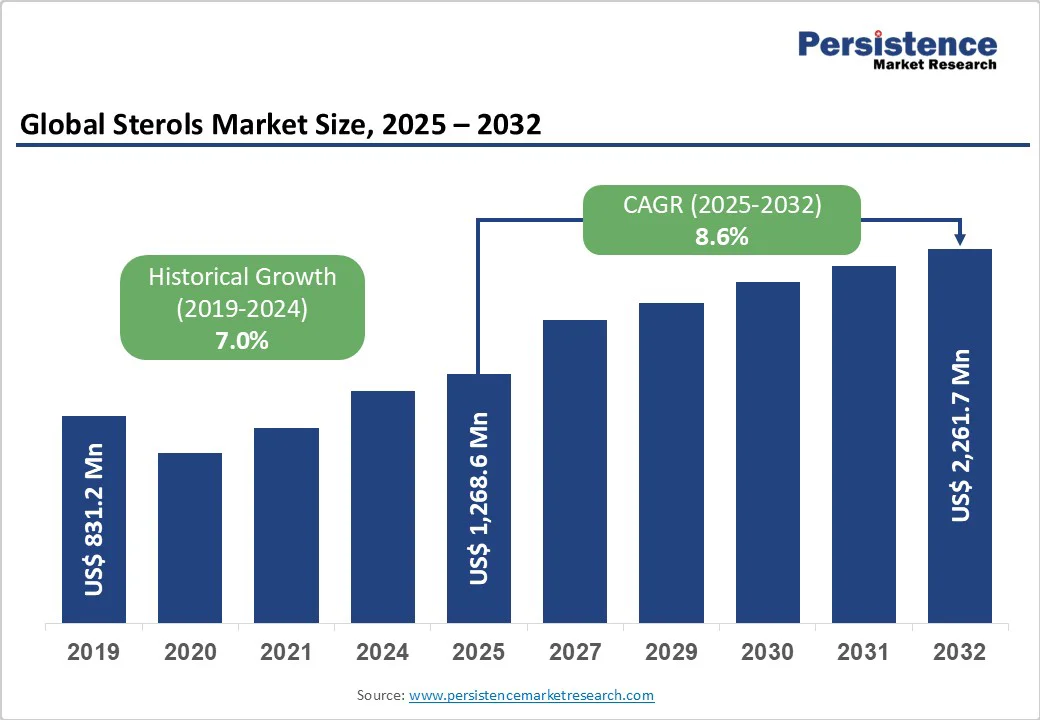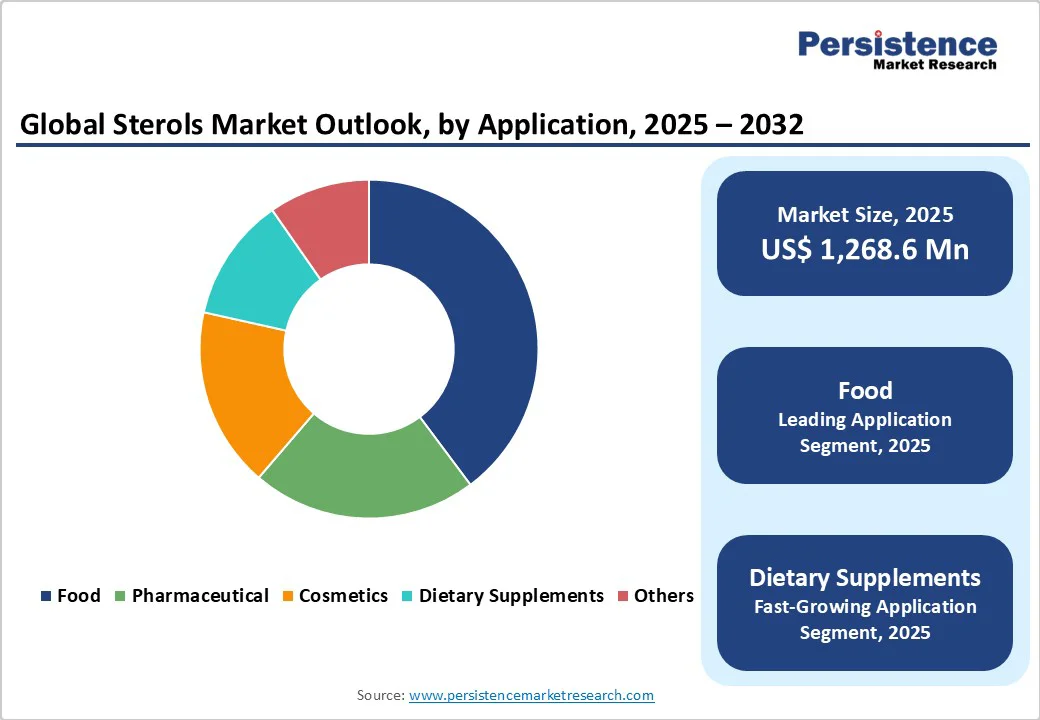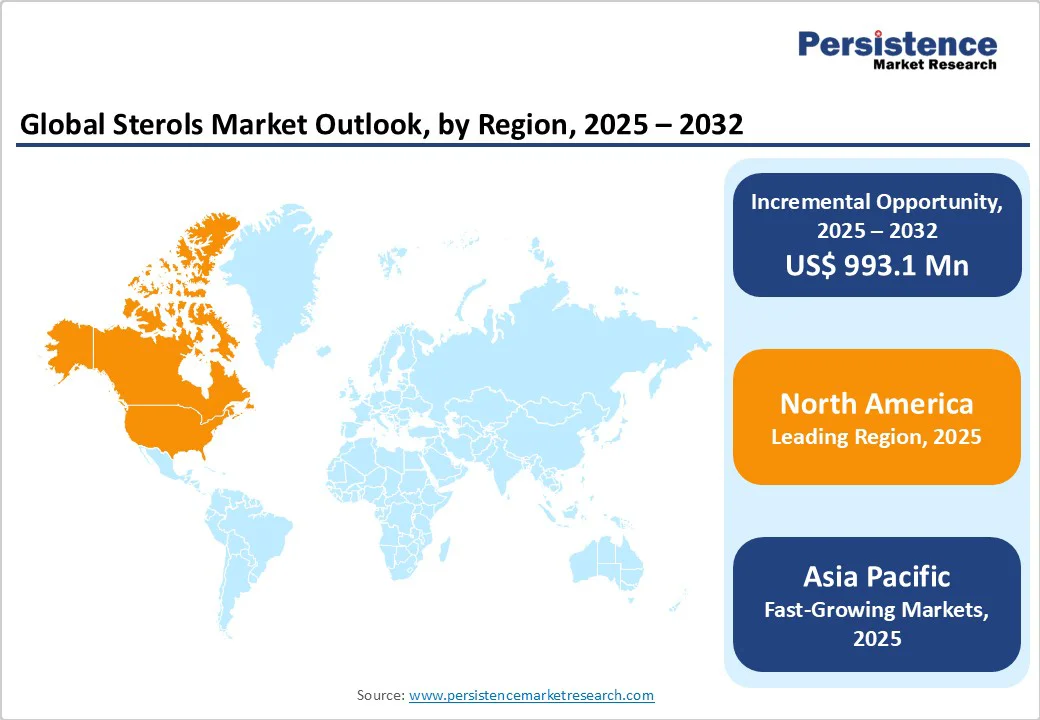ID: PMRREP22999| 199 Pages | 23 Oct 2025 | Format: PDF, Excel, PPT* | Food and Beverages

The global sterols market is expected to reach US$1,268.6 million in 2025. It is expected to reach US$2,261.7 million by 2032, growing at a CAGR of 8.6% during the forecast period from 2025 to 2032, driven by rising health awareness and increasing demand for cholesterol-lowering and heart-healthy products.
Sterols, mainly sourced from vegetable and tall oils, are valued for their LDL cholesterol-lowering benefits. Rising demand for natural, plant-based ingredients and advancements in extraction technologies are driving their use in functional foods, supplements, and cosmetics. Supportive regulations and growth in the nutraceutical sector further boost global market expansion.
| Key Insights | Details |
|---|---|
| Sterols Market Size (2025E) | US$1,268.6 Mn |
| Market Value Forecast (2032F) | US$2,261.7 Mn |
| Projected Growth (CAGR 2025 to 2032) | 8.6% |
| Historical Market Growth (CAGR 2019 to 2024) | 7.0% |

Cardiovascular diseases (CVDs) remain the leading cause of mortality worldwide, claiming approximately 17.7 million lives annually, according to the World Health Organization, which accounts for nearly 31% of global deaths. Among these, 80% of deaths result from heart attacks and strokes, with over 75% occurring in developing nations. Elevated cholesterol levels significantly increase the risk of CVDs, prompting a rising focus on preventive measures.
Plant sterols have emerged as an effective dietary solution, as regular consumption of 1.5-3 grams daily can lower LDL-cholesterol by 7-12.5% within two to three weeks, substantially reducing cardiovascular risks. This scientific evidence is driving the growing adoption of sterol-fortified foods, functional beverages, and dietary supplements among health-conscious individuals and patients seeking natural cholesterol management. As awareness of heart health rises globally, the demand for sterols is expected to continue its upward trajectory.
Sterols suppliers, despite targeting high future potential markets (developing markets), have not been able to demonstrate significant presence as well as penetration in developing countries such as India, China, Brazil, South Africa, and other developing nations. Limited awareness of the health benefits of sterol consumption is restraining market growth and preventing the segment from reaching its full potential.
Consumer purchasing power and per capita healthcare expenditure in these countries are also increasing year on year, thereby creating a pool of potential targets for sterol manufacturers and suppliers. Low consumer awareness and limited penetration of sterol-enriched foods and beverages are key factors expected to hinder the growth of the sterol market. Inevitably, sterol suppliers, particularly regional and local players, will tap into these emerging markets. Companies that fail to strengthen their distribution networks risk missing out on these growing market opportunities.
Consumers are rapidly shifting toward dietary supplements and functional foods to prevent health issues caused by not meeting dietary requirements. A growing number of consumers, especially baby boomers, are primarily preferring those foods that help prevent chronic conditions such as cardiovascular diseases, high blood pressure, high cholesterol, diabetes, and others related to aging. As a result, demand for healthy food products is growing faster.
Food manufacturers are leveraging the benefits of sterols by combining them with other ingredients to capitalize on the rising demand for products that reduce cholesterol and offer a unique taste. Companies are adding functional ingredients such as plant sterols and fruit-based flavors to their food products, intended for specific nutritional purposes or as dietary foods.
For instance, Unilever’s brand, Flora ProActiv, offers a wide range of cholesterol-lowering products, such as spreads and milk, and has also launched a new flavored range of drinks in pomegranate, raspberry, mango, cherry, strawberry, and others.
The powder form of sterols holds the largest market share due to its versatility, stability, and ease of incorporation across diverse applications. Powders offer uniform dosing, making them ideal for functional foods, dietary supplements, and beverages, where precise formulation is critical.
Unlike liquids or granules, powdered sterols exhibit superior shelf life and thermal stability, minimizing degradation during processing or storage. Powders allow seamless blending with other ingredients without altering texture or taste, which is essential for consumer acceptance. Manufacturers also prefer powders for cost-effective packaging, transport, and storage. These practical advantages, coupled with the growing demand for fortified and nutraceutical products, solidify the powder segment’s dominance in the global market.
The food industry holds the highest market share in the market, due to the growing consumer demand for heart-healthy and functional foods. Sterols are widely incorporated into everyday food products such as dairy, bakery, spreads, and beverages to help reduce LDL cholesterol, making them highly attractive for health-conscious consumers.
Food manufacturers leverage sterols’ natural origin and compatibility with diverse formulations, enabling easy fortification without affecting taste or texture. Additionally, regulatory support and health claims around cholesterol management boost sterol adoption in foods. The rising trend of preventive healthcare and increasing awareness of diet-related cardiovascular risks further reinforce the food industry’s dominance, positioning it as the largest end-user segment driving global sterols market growth.

North America, particularly the U.S., leads the market, due to high health awareness and strong functional food consumption. Consumers increasingly prefer cholesterol-lowering and heart-healthy products, driving sterol fortification in dairy, spreads, and beverages. The region benefits from well-established nutraceutical and pharmaceutical industries, advanced extraction technologies, and strict regulatory frameworks supporting health claims, which enhance product credibility.
Rising lifestyle diseases such as cardiovascular disorders and obesity have also fueled demand for preventive nutrition. Retail expansion through supermarkets, e-commerce, and specialty health stores ensures wide product accessibility. The U.S. also witnesses growing innovation in ready-to-drink functional beverages and fortified snacks, further consolidating North America’s dominance as the most mature and lucrative sterols market globally.
The Asia Pacific sterols market is emerging rapidly, driven by rising health awareness, increasing disposable incomes, and growing demand for functional and fortified foods. Countries, including China, India, Japan, and South Korea, are witnessing a surge in cholesterol-related lifestyle disorders, prompting consumers to adopt heart-healthy diets. Sterols are increasingly incorporated into dairy products, bakery items, beverages, and dietary supplements, supported by expanding urban retail networks and e-commerce platforms.
Traditional diets are evolving to include fortified and nutraceutical products, while government initiatives promoting preventive healthcare further boost market adoption. Additionally, local manufacturers are investing in advanced extraction technologies and product innovation, positioning Asia-Pacific as a fast-growing market with significant potential for sterols in both food and nutraceutical applications.

The global sterols market is highly competitive, with a mix of established multinationals and specialized regional players. Companies have strengthened their positions through strategic mergers, acquisitions, and partnerships, expanding product portfolios and enhancing distribution networks.
Focus on research and development has led to the introduction of high-purity sterols and innovative formulations tailored for functional foods, nutraceuticals, and pharmaceuticals. Market players are increasingly investing in process optimization and sustainable sourcing to improve quality and reduce production costs.
The sterols market is projected to be valued at US$1,268.6 Million in 2025.
Growing consumer focus on heart health and cholesterol management drives the demand for sterol-fortified foods and supplements.
The sterols market is poised to witness a CAGR of 8.6% between 2025 and 2032.
Expanding the inclusion of sterols in dairy, bakery, spreads, and beverages to meet growing heart-health awareness.
The key players in the sterols market include The Archer Daniels Midland Company, BASF SE, Cargill, Inc., and Raisio Plc.
| Report Attribute | Details |
|---|---|
| Historical Data/Actuals | 2019 - 2024 |
| Forecast Period | 2025 - 2032 |
| Market Analysis | Value: US$ Mn |
| Geographical Coverage |
|
| Segmental Coverage |
|
| Competitive Analysis |
|
| Report Highlights |
|
By Form
By Source
By End-user
By Region
Delivery Timelines
For more information on this report and its delivery timelines please get in touch with our sales team.
About Author